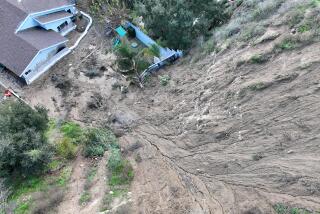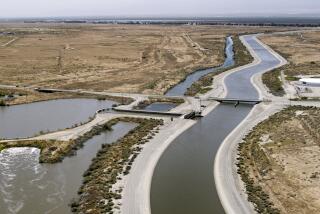Raging Red Puts ‘Floodway’ to Test
- Share via
WINNIPEG, Canada — Dug deep in the Canadian plains, a 30-year-old engineering marvel is being tested as it has never been tested before--by the gathering force of the Red River, fresh from its conquest of the North Dakota town of Grand Forks and now bearing down on this prairie capital in a spreading column 20 miles wide.
What stands between Winnipeg’s 660,000 inhabitants and the watery devastation that rolled over Grand Forks is “the Floodway,” a massive diversion channel gouged into the earth along the city’s east side that is designed to funnel high water harmlessly away until it rejoins the river north of town.
On Thursday, as the relentless Red approached its crest--flowing in such gorged volume that the force of its current now outstrips the Mississippi--the river rose to a flood stage not witnessed here since fur trappers roamed this territory in the 1820s.
Yet the Floodway appeared to be working exactly as its builders said it would, carrying torrents of choppy river water past the city, performing “like a champ,” said Chris Colp, a Canadian government dam manager. A plan to notify 10,000 residents of an imminent evacuation was scaled back at midday, even as thousands of volunteers and Canadian army troops continued bolstering the city’s river dike system.
“Without her,” said Colp, monitoring the Floodway from the waterlogged St. Andrew’s Dam lock house just north of the city, “we might as well wear our bathing trunks, eh?”
Even with all their faith in the Floodway’s proven ability to spirit off the worst of the flood, the Red River’s inundation of Grand Forks two weeks ago left many here unnerved and feeling vulnerable. Manitoba’s provincial capital is 60 miles north of the North Dakota line, and news coverage of the calamity in Grand Forks has been extensive.
“We’re just like they were, flat as a board and wide open,” said Dick Bohay, whose riverfront house stands--still dry--several hundred yards from the Red River’s swollen edge. “A lot of people haven’t been sleeping too well since then.”
In Winnipeg, a farming and railway hub that some describe as “Canada’s Chicago,” the nervousness is palpable. Despite the fact that the city gets pure spring water from an aqueduct that stretches deep into the prairie, Bohay’s son came home from school panicked about a rumor he heard that Winnipeg’s water system was in jeopardy. Colp’s local hardware store has been out of backup valves--used to plug sewage leaks--for a week.
While flood fright began to build after Grand Forks was swamped, many older Winnipeg residents have been stewing in their own fearful memories. In May 1950, the Red River flooded through Winnipeg, at the time protected only by a few earthen dikes. A quarter of the city was flooded, and 100,000 residents were forced from their homes.
The waters remained for 55 days, long enough to prod stunned officials then to order construction of the Floodway--and now to cause Bohay to lay awake several nights last week, wondering whether he would have to flee again, as he did as a child.
“You know it’s supposed to work,” he said. “All the engineers say so. But they’re only guaranteeing 98% success. I worry about that 2%.”
Not taking any chances, city and province officials ordered a series of hurried, last-minute public works projects last week to add to Winnipeg’s defenses. In five days, thousands of soldiers and volunteers built a new 25-mile line of clay and sandbag dikes south of the city to prevent the river from making an end run around an old flood wall. And to shore up the new wall further, residents have towed hundreds of old cars and buses down to the dike over the past several days, abandoning them in front of the new earthen berm, where they are being used as jetties to break up wind-whipped waves.
By Thursday morning, the few muddy tracts of land that remained south of Winnipeg looked like a giant salvage yard. Crushed and flattened cars, layered on top of each other like metal pancakes, lay strewn next to rusting school buses and monstrous bales of flax.
“It better work,” said Peter Unruh, a mechanic who gave his old Dodge Dart one last baleful look. “That car can rot at the bottom for all I care. I just don’t want the river anywhere near me.”
Winnipeg Mayor Susan Thompson said the river would remain near its crest for at least a week, prompting worry that more than 40 miles of earthen gumbo and sandbags on the city’s southern flank could spring major leaks.
But even if “all the dikes in the city fail,” pointed out Bill Rannie, a professor of geology with the University of Winnipeg, “we’re still 98% protected by the Floodway.”
The giant ditch snakes for 29 miles along Winnipeg’s eastern edge, able to divert up to 59,000 cubic feet of water moving past each second. Hydrologists estimate that the wall of flood water that reached Winnipeg on Thursday came at more than 138,000 cubic feet per second--far more than the channel could handle alone.
But so far, the trough has been wide and deep enough to allow the city’s dike system to handle the rest of the river water that still flows over its natural course through the center of town.
Since last week, city workers have slowly opened massive concrete gates south of Winnipeg that normally close off the Floodway from the river. The spillover funneled into the Floodway runs north, rejoining the Red River just outside the city in a boiling torrent so loud and violent that Canadian Mounties have been called to the banks nearby to keep gawkers away.
“You don’t realize how powerful this river is until you see it dump out here,” Rolly Bernard, a Provincial highway worker, yelled over the roar of the spray. “It really shows you how the Floodway’s doing the job.”
Despite costing $63 million (Canadian) to build from 1962 until 1968 and requiring more excavation than the Canadian portion of the St. Lawrence Seaway, the Floodway’s capacity is dwarfed by even larger spillways that protect New Orleans, Baton Rouge and New Madrid, Mo. from floods. Diversion channels like those and Winnipeg’s are “no silver bullets” without dikes and other water control measures, said Gerald Galloway, a former U.S. Army engineer who is now dean of faculty at the Industrial College in Washington.
But outclassed as it is by its American counterparts, the Floodway appeared to be working well enough Thursday to persuade those who know its most obscure dimensions to breathe a little easier.
“We’re not safe yet,” said Colp, whose co-workers were hunched over brooms, sweeping out water from the lock house--the first time the station has been flooded since it was built in 1910. “But we wouldn’t be able to stand here and sweep out what little water we have if that Floodway wasn’t doing its job.”
More to Read
Sign up for Essential California
The most important California stories and recommendations in your inbox every morning.
You may occasionally receive promotional content from the Los Angeles Times.










